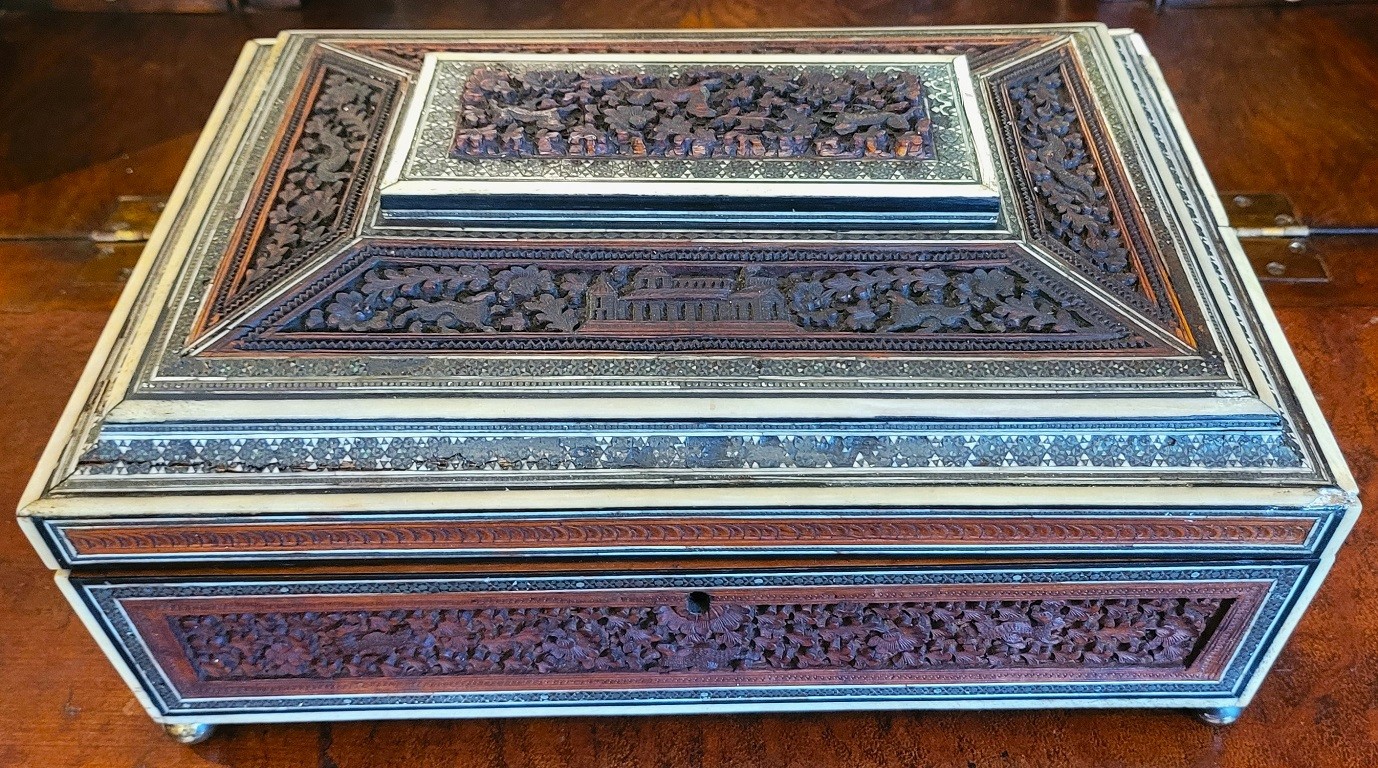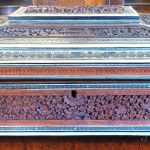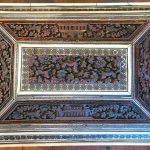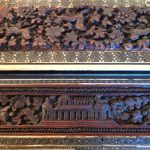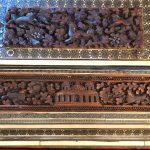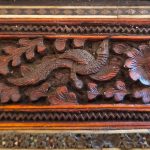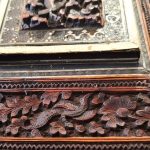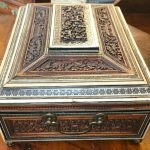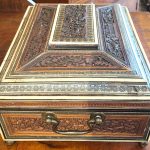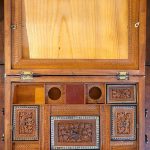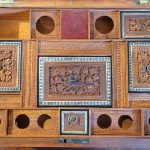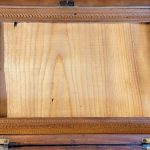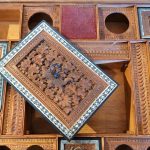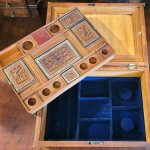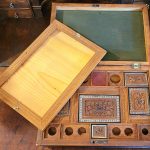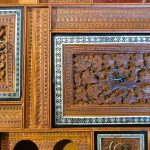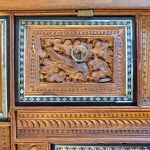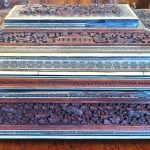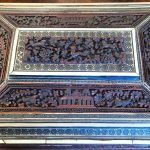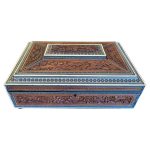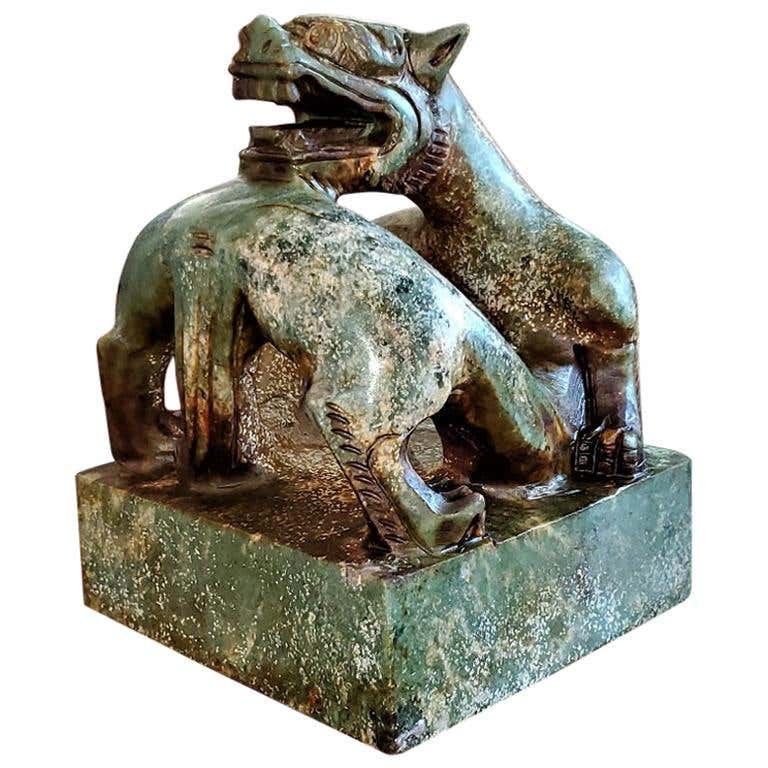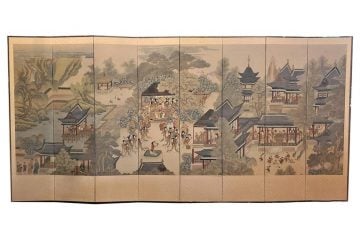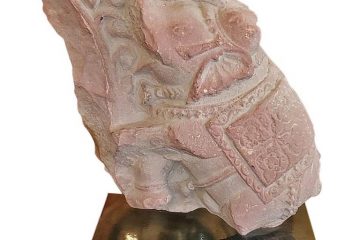19C Anglo Indian Highly Carved Padouk Wood with Sadeli Mosaic Inlay Sewing Box
PRESENTING A LOVELY 19C Anglo Indian Highly Carved Padouk Wood with Sadeli Mosaic Inlay Sewing Box.
Made in Bombay, India, Circa 1880.
The box is made of sandalwood with highly carved raised padouk wood panels on all sides, depicting temple scenes, animals and foliage.
The box is in a sarcophagus form.
It is edged in bone (and we can tell it is bone and not ivory, from the color and evidence of capillaries, which are not found in ivory), and banded with Bombay Sadeli mosaic and ebony veneer.
The lid opens to reveal a removable tray with various open compartments and lidded compartments. 5 lidded compartments, 1 unlidded compartment and 8 holders for thimbles, etc
The tray lifts to reveal a blue velvet (original) lined section, for storing jewelry etc, with sections for collars etc.
The inside of the lid has a removable mirror (the mirror is missing on this one but can easily be replaced). Behind the mirror is the original green velvet lining.
It has its original brass carry handles on the sides and sits on 4 silvered button feet (of more recent origin).
Some repairs to the exterior and condition issues (priced accordingly), but still a LOVELY COLLECTIBLE box!
These boxes were made by superb Indian craftsmen, specifically for sale to the ruling British elite. These types of boxes, carved padouk and sandalwood, (whilst beautiful and superbly crafted) were of a lesser quality, than the more profusely and intricately mosaic inlay, tortoiseshell and ivory boxes, made for the British ‘Upper Classes’ in the areas of Bombay and Vizagapatam. These type of boxes were much more affordable back in 1880 (and indeed today) and would probably have been bought by mid-level diplomats, civil servants or visitors.
Sewing boxes (in general), were in EVERY Victorian home in Britain in the 19th Century and like other boxes etc were ‘status symbols’ of your place in society! The more ornate the box, the more ‘Upper Class’ you were!
SADELI MOSAIC: “Anglo Indian boxes were made in India for the English residents from the early part of the 18th century. They were brought back or sent back to England usually by the people who had commissioned them. From the beginning of the nineteenth century they were imported more commercially, although not in any significant numbers until the middle decades. They were very highly valued, especially the early ones, to the extent that the designs were copied on late 19th and early 20th century tins.
The ancient art of Sadeli Mosaic is said to have been introduced from Shiraz in Persia via Sind to Bombay, a long time before the Anglo Indian boxes were made. It was a technique, which required a high degree of skill and patience. It was executed very lavishly, in that the frequent cuts wasted a great amount of the precious materials used. The workmanship was however more than commensurable to the value of the materials.
Ivory, silver, pewter (or other metals), wood and horn were cut into faceted rods which were bound together to form geometric patterns. When the glue has set, the rods were sliced in transverse sections. This gave the maker a number of angled circular pieces in the original pattern. Several variations of patterns could be achieved by combining the materials in different ways. The ivory was sometimes dyed green to give an extra color.
The mosaic pieces in a combination of patterns, often separated by ivory, ebony, horn or silver stringing were used to veneer sandalwood boxes. In the early boxes, which date from the turn of the 18th to the 19th century, there are large panels of mosaic covering tops and sides of boxes. It took incredible skill to cover such large areas without any shakes or wavering of the pattern. The corners and joins on these boxes are impeccably matched.
The makers (reputed to be Persian) of Sadeli mosaic made in the first two decades of the 19th century displayed a total understanding of the qualities of the different materials they used. They combined substances, which can expand and contract according to atmospheric conditions with others, which are hard and unyielding. The result was a sharp definition of the lines and patterns, which made up the whole design.
On the early boxes the designs look deceptively simple. The fact is, they emerged from a culture, which had mastered geometry and understood how to generate a pattern from a set number of points. The patterns are so harmoniously combined that their incredible complexity is not immediately apparent.
The earliest Sadeli boxes are of simple rectangular shapes. The combination of the diverse patterns is a triumph of artistic judgment, impeccable workmanship and deep respect for the material in hand. The boxes have an opulence emanating from the richness of the materials, yet the total control of these materials and the cerebral nature of the overall designs give them a restrained dignity. These early Sadeli boxes are now very rare indeed.
The carved Anglo Indian boxes fall into two very distinctive categories:
1. Early 19th century sandalwood boxes which were finely carved with repetitive floral and bird motifs and
2. Later 19th and 20th century wooden boxes much more crudely carved with or without late period Sadeli mosaic.
There are of course variations in the quality of these later boxes and some of them are very striking.
Boxes from the first category are very rare. ”
Link: http://hygra.com/anglo.html
19C Anglo Indian Highly Carved Padouk Wood with Sadeli Mosaic Inlay Sewing Box
Provenance: Part of our extensive Anglo-Indian Collection
Dimensions: 5.5 inches High, 12.3 inches wide and 8.8 inches deep
Condition: Good original condition. Some minor professional repairs.


